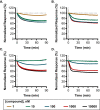The luminescent HiBiT peptide enables selective quantitation of G protein-coupled receptor ligand engagement and internalization in living cells
- PMID: 32107310
- PMCID: PMC7152755
- DOI: 10.1074/jbc.RA119.011952
The luminescent HiBiT peptide enables selective quantitation of G protein-coupled receptor ligand engagement and internalization in living cells
Abstract
G protein-coupled receptors (GPCRs) are prominent targets to new therapeutics for a range of diseases. Comprehensive assessments of their cellular interactions with bioactive compounds, particularly in a kinetic format, are imperative to the development of drugs with improved efficacy. Hence, we developed complementary cellular assays that enable equilibrium and real-time analyses of GPCR ligand engagement and consequent activation, measured as receptor internalization. These assays utilize GPCRs genetically fused to an N-terminal HiBiT peptide (1.3 kDa), which produces bright luminescence upon high-affinity complementation with LgBiT, an 18-kDa subunit derived from NanoLuc. The cell impermeability of LgBiT limits signal detection to the cell surface and enables measurements of ligand-induced internalization through changes in cell-surface receptor density. In addition, bioluminescent resonance energy transfer is used to quantify dynamic interactions between ligands and their cognate HiBiT-tagged GPCRs through competitive binding with fluorescent tracers. The sensitivity and dynamic range of these assays benefit from the specificity of bioluminescent resonance energy transfer and the high signal intensity of HiBiT/LgBiT without background luminescence from receptors present in intracellular compartments. These features allow analyses of challenging interactions having low selectivity or affinity and enable studies using endogenously tagged receptors. Using the β-adrenergic receptor family as a model, we demonstrate the versatility of these assays by utilizing the same HiBiT construct in analyses of multiple aspects of GPCR pharmacology. We anticipate that this combination of target engagement and proximal functional readout will prove useful to the study of other GPCR families and the development of new therapeutics.
Keywords: G protein-coupled receptor (GPCR); HiBiT; NanoLuc; adrenergic receptor; bioluminescence; bioluminescence resonance energy transfer (BRET); endogenous tagging; kinetics; ligand engagement; receptor internalization.
© 2020 Boursier et al.
Conflict of interest statement
All authors were Promega employees during manuscript preparation
Figures









Similar articles
-
Equilibrium and Kinetic Measurements of Ligand Binding to HiBiT-tagged GPCRs on the Surface of Living Cells.Bio Protoc. 2020 Dec 20;10(24):e3861. doi: 10.21769/BioProtoc.3861. eCollection 2020 Dec 20. Bio Protoc. 2020. PMID: 33659503 Free PMC article.
-
An Integrated Approach toward NanoBRET Tracers for Analysis of GPCR Ligand Engagement.Molecules. 2021 May 12;26(10):2857. doi: 10.3390/molecules26102857. Molecules. 2021. PMID: 34065854 Free PMC article.
-
Development of a HiBiT Peptide-Based NanoBRET Ligand Binding Assay for Galanin Receptor 1 in Live Cells.ACS Chem Biol. 2025 Jul 18;20(7):1594-1608. doi: 10.1021/acschembio.5c00166. Epub 2025 Jul 4. ACS Chem Biol. 2025. PMID: 40616201
-
NanoBRET Approaches to Study Ligand Binding to GPCRs and RTKs.Trends Pharmacol Sci. 2018 Feb;39(2):136-147. doi: 10.1016/j.tips.2017.10.006. Epub 2017 Nov 10. Trends Pharmacol Sci. 2018. PMID: 29132917 Review.
-
New Horizons on Molecular Pharmacology Applied to Drug Discovery: When Resonance Overcomes Radioligand Binding.Curr Radiopharm. 2017;10(1):16-20. doi: 10.2174/1874471010666170208152420. Curr Radiopharm. 2017. PMID: 28183248 Review.
Cited by
-
Coelenterazine-Dependent Luciferases as a Powerful Analytical Tool for Research and Biomedical Applications.Int J Mol Sci. 2020 Oct 10;21(20):7465. doi: 10.3390/ijms21207465. Int J Mol Sci. 2020. PMID: 33050422 Free PMC article. Review.
-
Molecular Effects of Auto-Antibodies on Angiotensin II Type 1 Receptor Signaling and Cell Proliferation.Int J Mol Sci. 2022 Apr 2;23(7):3984. doi: 10.3390/ijms23073984. Int J Mol Sci. 2022. PMID: 35409344 Free PMC article.
-
NanoBRET and NanoBiT/BRET-Based Ligand Binding Assays Permit Quantitative Assessment of Small Molecule Ligand Binding to Smoothened.Methods Mol Biol. 2022;2374:195-204. doi: 10.1007/978-1-0716-1701-4_17. Methods Mol Biol. 2022. PMID: 34562254
-
Rapid and high-throughput screening of proteolysis targeting chimeras using a dual-reporter system expressing fluorescence protein and luciferase.BMC Biol. 2025 Feb 21;23(1):51. doi: 10.1186/s12915-025-02153-7. BMC Biol. 2025. PMID: 39985000 Free PMC article.
-
Strategies for Site-Specific Labeling of Receptor Proteins on the Surfaces of Living Cells by Using Genetically Encoded Peptide Tags.Chembiochem. 2021 May 14;22(10):1717-1732. doi: 10.1002/cbic.202000797. Epub 2021 Feb 26. Chembiochem. 2021. PMID: 33428317 Free PMC article. Review.
References
-
- Schuetz D. A., de Witte W. E. A., Wong Y. C., Knasmueller B., Richter L., Kokh D. B., Sadiq S. K., Bosma R., Nederpelt I., Heitman L. H., Segala E., Amaral M., Guo D., Andres D., Georgi V., et al. (2017) Kinetics for drug discovery: an industry driven effort to target drug residence time. Drug Discov. Today 22, 896–911 10.1016/j.drudis.2017.02.002 - DOI - PubMed
MeSH terms
Substances
LinkOut - more resources
Full Text Sources
Other Literature Sources

